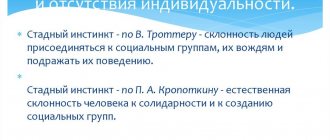Managing Aggression: Why do people become more aggressive and how to resist anger?
The word aggression translated means “movement towards an object.” Aggression is the energy that helps us achieve our goals in life and withstand competition. But this is with a normal level of aggression and its correct direction. And if not?
Bad luck haunts William (Michael Douglas). And now his accumulated aggression has passed the “boiling point”! (Film “I’ve had enough!”, 1993)
My son is in 11th grade. There are kids at school who provoke him into fights. Recently I was called to school and told that my son was aggressive and cruel. Perhaps he became like this because he saw his father's rudeness. My husband has a hard job, in a male team, conflicts often arise. Passions run high in our family. How to deal with aggression? How to deal with aggressive people? Maria, 42 years old, Tula.
For many people, the level of aggression is increased and the direction of energy is incorrect. For example, aggression can be directed toward entering college, pursuing a career, or achieving personal goals. But for some reason, a person directs it in a different direction, for example, towards a neighbor who is more fortunate in life, or towards the weak, or towards self-destruction.
Dangerous aggression
The only correct direction of this energy is life achievements, not “over the heads”, but along your own path. And also standing up for your rights. If energy is not used for its intended purpose, it becomes dangerous. Here are four types of misdirected aggression.
1 Identification with the aggressor. The most dangerous type of aggression provokes cruelty and crime. From childhood, a person is brought up in an atmosphere of cruelty. He is the object of bullying and learns that people are divided into two categories: strong (in his understanding, aggressive, cruel, who can mock, suppress) and weak (victims). This child no longer sees the other side of the world.
He doesn’t want to be weak, and he identifies with the strong (with the aggressor). Then in life he himself becomes cruel and aggressive. He has no pity for the victims, because in order to feel sorry, he needs to “take the place of the weak.” And he cannot afford this, he has suffered too much in the role of the weak. That is why they say that an aggressor or rapist is a victim of aggression and violence in the past.
2 Aggression suppressed. Most often this happens in childhood. The child is forbidden to get angry, defend his point of view, or fight back. Or he is physically and mentally weak and is afraid to show aggression even in the most harmless form. And it becomes a “quiet pool” in which “devils roam.” Aggression does not go away, it remains inside.
A quiet and harmless “nerd” may one day go off the rails in such a way that no one will find it enough.
If aggression never finds a way out, it will begin to destroy the person himself. Diseases, problems, complexes become attached. A person destroys himself with the help of alcohol, drugs, gambling and computer games.
3 Aggression of a loser. Envy, anger at the whole world, confidence that “everything is wrong” in the world, it is ruled by evil, money, etc. Instead of realizing oneself, a person becomes angry or takes revenge on those more fortunate. The person himself may not even be aware of the reasons for his aggression.
4 Aggression redirected. For example, at work your boss made you very angry, but you cannot enter into an open confrontation with him and take your anger out on an accessible object: your husband, your child. Unfortunately, it is the weaker ones who suffer here, those who cannot fight back.
Why is everyone so angry
In the modern world, rates of all types of aggression are rising. People were divided into lucky and unlucky, rich and poor. This means that losers take out their aggression on successful ones. And the successful are forced to fight for their place in the sun.
The frantic pace of life forces us to suppress aggression and take it out on our family. Because there is no time to sit down and talk with your opponent, to understand yourself, to calm down. TV is replete with scandals, violence and disasters. This increases the level of aggression tenfold.
How to deal with an aggressor?
The main thing, if you meet an aggressor, is not to be on the same wavelength with him. Any aggressor splashes out evil not on a random person, but on a suitable victim. If your level of aggression is elevated, you will attract the aggressor to you like a magnet. If you're on a different wavelength, he won't notice you. For example, in a dark alley they will ask a passerby who is angry at someone for a “light.”
If the aggressor attacks, do not succumb to provocation, remain calm, mentally play the role of a good person, remember Christian values. Even this is often enough to calm the aggressor.
The main thing is not to respond to aggression with anger. Even if the situation requires you to intimidate the aggressor, respond harshly, or otherwise stand up for yourself, do so, but remain calm inside. If the aggressor is reasonable (we are talking about your boss, not the bully), use psychological aikido: start your speech with the word “yes”, find something to agree with the aggressor on, take his position, sympathize.
Just numbers How often do you get angry?
Advice from a psychologist How to cope with your aggression
1 If you notice that you are often angry and irritable, try to understand what and why irritates you. Often what causes anger in us is precisely what we have in ourselves or what we cannot afford. A lonely and complex woman is annoyed by a nymphet in a miniskirt. Someone who is greedy but hides it will be enraged by greed in others.
2 Put yourself in the shoes of those who irritate you, think and feel like them. Maybe they have reasons to behave this way? Empathize with them.
3 If you often get angry and irritated with people for no reason, think: what is wrong in your life? Perhaps this is redirected aggression. Maybe you are not satisfied with your family relationships, and you lash out at your subordinates? Or vice versa. Think about a solution to your current problem.
4 If you are angry with a particular person and are thinking in your head “oh, what kind of person is he...!”, try to talk frankly with him and discuss the issues of concern. A frank conversation will clarify a lot.
5 If the level of aggression is off the charts, maybe you just need to rest? Get some sleep, do your favorite things, relax. Everyone has their own way of relaxing and cleansing from irritation: yoga, meditation, sports, sauna, communication, creativity.
Dear readers!
I'm waiting for your feedback at [email protected] .
Angela Kharitonova, practical psychologist.
Display of aggression
In everyday life, aggression manifests itself in different ways. Benevolent aggression is expressed in the following behavioral state: masculinity, perseverance, courage, bravery. Negative aggression manifests itself in rudeness, irritability, cruelty, and hatred. The main goal of this behavior is to create maximum protection for your body from unfavorable situations and unfriendly people.
Display of aggression
Verbal aggression is a condition in which psychological harm is caused to a loved one or a stranger using verbal speech. The person abruptly changes his soft tone to a rougher one, which over time turns into shouting and insults. The patient exhibits the following personality manifestations: verbal humiliation, insult, malicious slander, dissatisfied speech, threat of physical harm.
Verbal aggression is a manifestation of negative emotions, rudeness, and insults towards the interlocutor. An aggressive person has mocking intonations, obscene phrases, a raised loud voice, and rude irony. Speech aggression in a person is caused by negative emotions or negative behavior is provoked by the hostile attitude of the interlocutor in previous conversations. Aggression can also manifest itself in the presence of mental disorders of the patient, low level of his upbringing and social status.
Excitation transfer theory
Increased arousal is one of the important factors of aggressive behavior. Firstly, arousal does not go away quickly, so it can persist when moving from one situation to another. Secondly, it does not matter what caused the increased arousal, and if it is, the likelihood of aggression increases.
Let's say you are driving a car. Another driver cuts you off dangerously. You slammed on the brakes and almost got into an accident. Naturally, this caused you to become more aroused, and this is quite normal. After that, your friend calls you and asks something, and you respond by losing your temper and being rude to him.
Why did this happen? Social psychologists claim that the reckless driver who just cut you off is to blame for your harsh response to your friend. It's simple.
We recommend that you learn to perform several relaxation exercises to reduce the role of this factor.
We wish you success!
Genetics: the meanest one wins
Everything is simple here. The one who is better at biting, hitting, trampling or stabbing survives. If one creature defeats another, it is its genes that are passed on. Nothing can be done, laws of nature. This applies both to interspecific competition and to the struggle for a partner for reproduction.
We inherited aggression from all the millions of years of evolution. It's innate. This point of view was held to one degree or another by both Freud and evolutionary psychologists. We just need to make a couple of reservations. Firstly, a person can direct aggression into a completely peaceful direction, for example, overfulfilling a plan, practicing fencing, or writing feuilletons. Secondly, it is very tempting to reduce the entire human psyche to genetics. But we must understand that you and I are too complex creatures. At least more difficult than a rat or a moose.
Diagnostics
Diagnosis of aggression and identification of the causes of its occurrence is carried out by a psychotherapist or clinical psychologist. Typically, during examination, patients try to hide aggressiveness and negative character traits. It is for such situations that diagnostic procedures are prescribed using experimental techniques that make it possible to determine the presence of aggressiveness and hostility in the patient. Standard diagnostics are carried out using the following procedures:
- Conversation . The specialist conducts a conversation with the patient, finds out the reasons for the appearance of aggression, its duration and severity. Patients do not always explain to the doctor the presence of irritable and aggressive symptoms. In this regard, a detailed survey of relatives is carried out to obtain complete and objective information about the current condition of the patient.
- Condition monitoring . Aggressive reactions may occur in the patient during the clinical consultation. Aggressive patients experience irritability, short temper, and rudeness. A complete picture of the patient’s behavior and condition can be found in a hospital setting. Typically, patients exhibit verbal and physical aggression.
- Psychological testing. A psychodiagnostic study is carried out on the basis of testing, which allows us to assess the pronounced symptoms of aggression, the structure of its character and the presence of other negative signs of the patient.
Frustration: an unachieved goal makes you break and destroy
Let's start with the meaning of the term. The most common definition of frustration is that it is a state that occurs when a person experiences a need, sees a way to satisfy it, but is faced with an insurmountable obstacle. Let's say I'm really thirsty, I go to the soda machine, and it turns out to be broken. The rough but accurate equivalent of this word is bummer.
For a long time, psychology was dominated by the belief that frustration gives rise to aggression. Numerous studies have corrected this: frustration contributes to aggression. But not always. And not only her.
Competition “Bio/Mol/Text”-2020/2021
This work was published in the “Free Topic” category of the “Bio/Mol/Text” competition 2020/2021.
The general partner of the competition is the annual biotechnology conference BiotechClub, organized by the international innovative biotechnology company BIOCAD.
The sponsor of the competition is SkyGen: a leading distributor of life science products on the Russian market.
Competition sponsor: the largest supplier of equipment, reagents and consumables for biological research and production.
"Book" sponsor of the competition - "Alpina Non-Fiction"
The amygdala is a small paired structure resembling an almond in shape and size, and its volume varies from 1.24 to 1.68 cubic centimeters [1]. The tonsils in the brain should not be confused with the tonsils in the throat (aka tonsils). Yes, yes, “inflammation of the tonsils” and “removal of the tonsils” are not about brain surgery.
The two “brain” tonsils are located bilaterally (right and left) under the cerebral cortex in the temporal lobes (Fig. 1). Despite their modest size, the amygdala plays a key role in the emotional behavior that unites us with other animals. It is believed that these two small areas of the brain form an important part of the “threat system”, associated with feelings of fear, pain, the perception of negative stimuli, and providing the body with behavioral and neuroendocrine responses to them. Other parts of this system are the hypothalamus (attack area), prefrontal cortex (PFC), and periaqueductal gray (PAG) (Fig. 2) [2]. The emergence of excitation in this system leads to an adequate response of the body to environmental challenges—the “fight or flight response.”
Figure 1. Tonsils in the human brain (marked in red)
Wikipedia
Figure 2. Parts of the brain's "danger system" responsible for processing negative stimuli and initiating the body's adaptive response. Several pathways involved in the body's aggressive response (Aggressive behavior) are shown. Amygdala connections (Amygdalar route), hypothalamic connections (Hypothalamic route) and the influence of external stimuli (Environmental stimuli and processing): auditory, visual (Visual and auditory cues) and even olfactory (Olfactory cues).
[2]
Disturbances in the functioning of this system underlie a variety of conditions, from PTSD (post-traumatic stress disorder), panic attacks and anxiety disorders to uncontrollable outbursts of rage and antisocial behavior. In addition, the amygdala is one of the most common sources of epileptic seizures, the so-called. temporal lobe epilepsy, which is sometimes preceded by attacks of panic or aggression. Therefore, understanding the workings of the “danger system” may be the key to unlocking the symptoms of many human psychiatric and neurological diseases.
But how can we study the work of a system that is activated in situations that, frankly speaking, are not the most pleasant for a person - aggression and fear?
Culture: The hero strikes first
What do we study in history lessons at school? England is at war with France, the crusaders are capturing Jerusalem, the German army is advancing... What are almost half of the films dedicated to? The hero shoots. The hero explodes. The hero kicks him in the jaw.
The lion's share of images in world culture is associated with violence. And it doesn’t matter what level this culture is - an epic saga or a cheap comic book. We consume both high and low products and at the subcortical level we fix: a hero is the one who fights. And I want to be a hero.
Treatment of aggression
Aggression is not an indicator of a person’s response to life’s difficulties, conflicts, disputes and failures. Aggression manifests itself when there is a disturbance in the emotional background, mental activity, or behavioral state of the individual. Timely and proper treatment will help overcome attacks of rage, aggression, impulsiveness and prevent the development of mental illness. Treatment consists of psychotherapeutic sessions, group trainings, and drug therapy.
- Psychotherapeutic sessions. Clinical conversations conducted by a psychotherapist allow us to identify the causes of anger, irritability, impulsivity and aggression in the patient. When conducting psychotherapeutic sessions, psychoanalysis, cognitive behavioral therapy, autogenic training, Gestalt therapy, and hypnosis are used.
- Group trainings. The specialist demonstrates unusual situations to patients, shows several options for adequate behavior to maintain self-control over their own emotions. Negative situations and circumstances in various areas of human life are studied. Practical classes are conducted with the participation of each patient.
- Drug therapy. Drug treatment is necessary for patients who have a severe form of aggression. It is these patients who pose a threat to the entire society. Taking medications will help reduce the level of aggressiveness, irritability, and anger. Comprehensive treatment based on medications and psychotherapeutic sessions will eliminate attacks of aggression and prevent their further occurrence.










